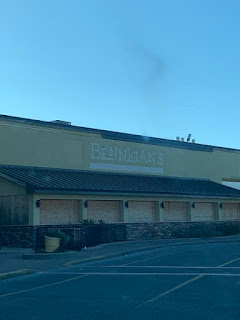Panama City Beach, FL, is a tourist destination. The coastal
highway running through that area is lined with resorts, night clubs, mini
theme parks and restaurants. Inland of that, by only about 10 or 15 minutes, is
the mainland Panama City. It is small, largely business and industrial, with
one central hub for all the residents and tourists alike.
The “shopping and restaurant” district of Panama City
includes several strip malls and free-standing chain restaurants. There are
well-known brand names like Target, Lowe’s, Books a Million, Beall’s Outlet and
TJ Maxx as well as Olive Garden, Chili’s, O’Charley’s, Chick Fil A and more.
This “district” stretches out west along 23rd street, towards the
beach. But much of it seems to be consolidated into several blocks that center
around the old Panama City Mall.
In October 2018, Hurricane Michael ripped through Panama
City and caused significant damage. As of now, more than a year later, the
damage is still prominent in places. Businesses that were already shuttered
before the storm have been left standing half-demolished by the winds. Their
rooftops are peeling back like cat food cans. Some other businesses were open at
the time but never returned, and also look like they were part of a war zone.
The biggest casualty of it all, however, has to be the mall.
Panama City Mall opened in 1976. It was small, at only a
little over 600,000 square feet. It boasted just three anchors. At the time
that Hurricane Michael struck in 2018, those anchors were Dillard’s, JC Penney
and Planet Fitness. Present day, all three of them are still open and operating
normally. The mall itself is permanently closed. It sustained so much damage to
its interior corridors that the company who owned it, Hendon Properties,
determined permanent closure was the only option.
Apparently, they didn’t think it was worth what would have
to be borrowed and sunk into it to restore it.
The mall’s website is still up and running with only the
surviving anchor stores and surrounding restaurants listed. The building itself
is covered in boards and looks rather ominous. Pictures of the interior can be
found online, taken before the storm closed it down. I don’t know much about
what was there before the hurricane, but whatever stores were inside must have
been doing just “not-well-enough” to warrant the mall not being worth the
trouble of restoring.
New Orleans had the same type of thing happen, but on a
larger scale. A few malls were left permanently boarded up and rotting away
after Katrina flooded them in 2005. No one has ever tried to rebuild them due
to the areas surrounded being left largely vacant when residents decided not to
return.
I’ve watched a few malls steadily decline here in Florida
over the years, reaching dead-mall status. (Jacksonville’s Regency Square HAS to be the worst case of this.) I’ve also read up on some that have closed due to
economic shift or decline in the past few decades and have since been replaced by shopping
centers. But this is the first case I’ve seen up close and personal of a mall
that was taken out by what they call an “act of God”.





No comments:
Post a Comment